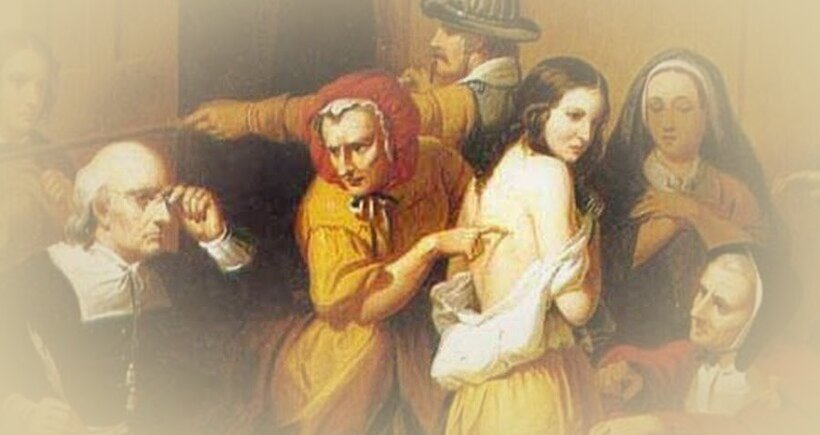
Devil’s mark : According to witch-hunters, the Devil always permanently marked the bodies of his initiates to seal their pledge of obedience and service to him. He marked them by raking his claw across their flesh or using a hot iron, which left a mark, usually blue or red, but not a scar. Sometimes he left a mark by licking them. The Devil supposedly branded witches at the end of initiation rites, which were performed at nocturnal Sabbats.
The marks were always made in “secret places,” such as under eyelids, in armpits and in body cavities. The mark was considered the ultimate proof of being a witch — all witches and sorcerers (see sorcery) were believed to have at least one. All persons accused of witchcraft and brought to trial were thoroughly searched for such a mark. Scars, birthmarks, natural blemishes and insensitive patches of skin that did not bleed qualified as Devil’s marks. Experts firmly believed that the mark of Satan was clearly distinguishable from ordinary blemishes, but in actuality, that was seldom the case. Protests from the victims that the marks were natural were ignored.
Accounts of being marked by the Devil were obtained in the “confessions” of accused witches, who usually were tortured to confess (see torture). Inquisitors stripped off the accused witch’s clothes and shaved off all body hair so that no square inch of skin was missed. Pins were driven deeply into scars, calluses and thickened areas of skin (see pricking). Since this customarily was done in front of a jeering crowd, it is no surprise that some alleged witches felt nothing from the pricks.
Inquisitors believed that the Devil also left invisible marks upon his followers. If an accused witch had no likely natural blemishes that could be called a Devil’s mark, pins were driven into her body over and over again until an insensitive area was found.
British anthropologist Margaret A. Murray said that Devil’s marks were actually tattoos, marks of identification, which she offered as support of her contention that witchcraft as an organized pagan religion had flourished in the Middle Ages. Murray’s controversial ideas have been debunked. Devil’s marks were sometimes called witch’s marks.
SEE ALSO:
FURTHER READING:
- Barstow, Anne Llewellyn. Witchcraze: A New History oj the European Witch Hunts. San Francisco: Pandora, 1994.
- Cavendish, Richard. The Black Arts. New York: Putnam, 1967.
- Lea, Henry Charles. Materials Toward a History of Witchcraft. Philadelphia: University of Pennsylvania, 1939.
- Maple, Eric. The Dark World of Witches. New York: A.S. Barnes & Co., 1962.
SOURCE:
The Encyclopedia of Witches, Witchcraft and Wicca written by Rosemary Ellen Guiley – Copyright © 1989, 1999, 2008 by Visionary Living, Inc.

A Devil’s mark is a permanent mark made upon the body by the Devil as part of a Pact. Sometimes called a “witch’s mark,” the Devil’s mark was a telltale sign and damning evidence in the witch trials of the Inquisition. According to Demonologists, the Devil always permanently marked the bodies of his initiates to seal their pledge of obedience and service to him. At the moment they renounced their faith, he marked them by raking his claw across the flesh or using a hot iron, which left a mark, usually blue or red, but not always a scar. Sometimes he left a mark by licking people. Branding was done when recruits were initiated at Sabbats and when anyone entered into a formal pledge of allegiance to the Devil. The marks could be anywhere on the body. In his book Demonolatry (1595), Nicholas Remy listed brows, left shoulders, hips, breasts, tops of heads, and backs as places bearing marks. Sometimes the marks were made in “secret places,” such as under eyelids, in armpits, and in body cavities.
According to Francesco-Maria Guazzo, an Italian Demonologist of the 17th century, in his work Compendium Maleficarum (1608):
And the mark is not always of the same description; for at times it is like the footprint of a hare, or a spider or a dog or a dormouse. Neither does he always mark them upon the same place: for on men it is generally found on the eyelids, or the arm-pit or lips or shoulder or posterior; whereas on women it is found on the breasts or private parts.
The Devil’s mark was considered the proof of Witchcraft and sorcery. It was believed that every person who trafficked with the Devil had one or more, and it was usually insensitive to pain. Persons accused of witchcraft and brought to trial were thoroughly searched for such a mark, and some had all their body and head hair shaved off in the process. Pins were driven into scars, moles, warts, and skin discolourations. If the person felt little or no pain, or if there was no bleeding, then a Devil’s mark was declared.
Inquisitors believed that the mark of Satan was clearly distinguishable from ordinary blemishes, but in actuality, that was seldom the case. Protests from the victims that the marks were natural were ignored. If no mark was found, or if pricking a mark caused pain, inquisitors declared them Devil’s marks anyway, falling back on authoritative statements made by Guazzo and others that the Devil did not necessarily mark everyone, but only those he suspected of turning on him, and some of the marks were painless and others were not. Some inquisitors held that Devil’s marks could even be invisible. An innocent person had no way around a determined inquisitor.
Once Devil’s marks were found, victims were tortured into confessing how they were acquired. No less than tales of pacts and wild initiatory rites at sabbats would satisfy the inquisitors.
SEE ALSO:
FURTHER READING:
- Guazzo, Francesco-Maria. Compendium Maleficarum. Secaucus, N.J.: University Books, 1974.
- Lea, Henry Charles. Materials toward a History of Witchcraft. Philadelphia: University of Pennsylvania Press, 1939.
- Remy, Nicholas. Demonolatry. Secaucus, N.J.: University Books, 1974.
SOURCE:
The Encyclopedia of Demons and Demonology – Written by Rosemary Ellen Guiley– Copyright © 2009 by Visionary Living, Inc.

